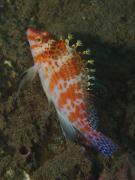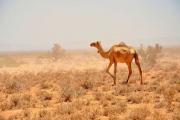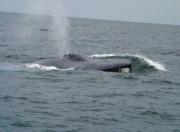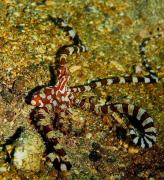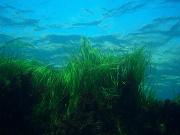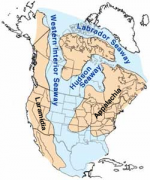Radio Program
Our regular Science and the SeaTM radio program presents marine science topics in an engaging two-minute story format. Our script writers gather ideas for the radio program from the University of Texas Marine Science Institute's researchers and from our very popular college class, Introduction to Oceanography, which we teach to hundreds of non-science majors at The University of Texas at Austin every year. Our radio programs are distributed at to commercial and public radio stations across the country.
There aren’t many worms that you could truthfully describe as “beautiful.” One of the few is found in the most colorful environments on Earth: coral reefs. It’s known as the Christmas tree worm because it looks like a colorful little fir tree. And it comes in an amazing variety of hues: red, blue, purple, yellow, and many others.
The colorful dwarf hawkfish has a colorful life story. Found on coral reefs from Australia to Japan, it lives in harems -- one large male with an entourage of several females. If the male gets greedy, though, things can change. One of the females can become a male and take half of the harem. And researchers recently found that if the new male is challenged by another male, he can change back to a female.
The hawkfish isn’t the only fish that can change sex. In fact, it’s a fairly common trait, especially among fish that live on reefs.
In July 1879, the USS Jeannette left San Francisco, headed for the north pole. No one had reached the pole yet, and scientists suspected it was ice free, with a ring of ice around it. Just two months later, though, the ship was frozen fast in the ice. It floated along for almost two years before the ice crushed it. Crewmembers then faced a long trek across sea and land that killed 20 of them -- only 13 survived.
Dolphins are among the “chattiest” creatures in the oceans. They use sound to find and catch food, as part of their courtship rituals, and just to stay in touch with other dolphins.
Many of those sounds are short clicks and high-pitched squeaks. And a team of researchers is using computers to pick out patterns of these sounds produced by different species of dolphins and whales.
We all know that El Niño can have a big impact on the weather here in the United States. But El Niño’s effects aren’t limited to the U.S. They can alter the climate across the entire planet. In fact, an especially powerful El Niño may have triggered the deadliest famine in history.
The famine lasted from 1876 to ’78. It probably killed more than 50 million people. Most of the victims were in China, but there were many in Brazil, India, and parts of Africa as well.
To keep tabs on the health of whales, marine biologists sometimes catch the “snot” from the whales’ blowholes -- a mixture of water, mucus, and other substances. And in recent years, they’ve found a new way to catch it: with drones.
The small remote-controlled vehicles fly above a whale and wait for it to clear its lungs. A plate or dish then catches some of the material expelled through the blowhole. Biologists check the “blow” for the whale’s DNA, hormones, algae, bacteria, and other substances.
The right name can make all the difference in a marine organism’s reputation. Few, for example, could resist Wunderpus photogenicus -- the “photogenic wonderful octopus.” It has a reddish-brown body marked by patterns of white stripes and spots. And it can contort its body to resemble other creatures.
Wonderpus is found around the western rim of the Pacific Ocean, southward from the Philippines. Its body is only a few inches long, while its arms can span more than a foot.
Seagrass beds are complex ecosystems that support fish and other marine life. Perhaps it’s not surprising, then, that an effort to restore some seagrass beds worked best when several species of seagrass were planted together.
Seagrass is important for both marine life and human life. It provides habitat and hiding places for fish and many other marine organisms. That maintains a ready supply of those organisms for human consumption. Seagrass also helps protect the coastline from tropical storm damage, and stores carbon that otherwise would be in the air, making Earth even warmer.
The male Gulf corvina is a loudmouth. In fact, it may be too loud for its own good. Its sounds guide fishing boats right to its own spawning grounds. And that could endanger the entire corvina population.
Appropriately enough, Gulf corvina are a type of croaker. They inhabit the Gulf of California, between Baja California and the Mexican mainland. Every spring, the entire adult population gathers to spawn at the northern edge of the gulf -- at the mouth of the Colorado River. To help them attract mates, male corvina make a lot of noise -- a series of short, loud pulses.
A hundred million years ago, Kansas was inhabited by some creatures with big, sharp teeth: sharks up to 30 feet long, a fish that’s been described as a tarpon with fangs, and a 45-foot dinosaur that was one of the deadliest predators on the planet.
That’s because Kansas was at the bottom of a sea that stretched from the Arctic to the Gulf of Mexico. Known as the Western Interior Sea, it was up to a thousand miles wide. Its warm, shallow waters supported an abundance of life, including giant clams, giant fish, and giant dinosaurs.


